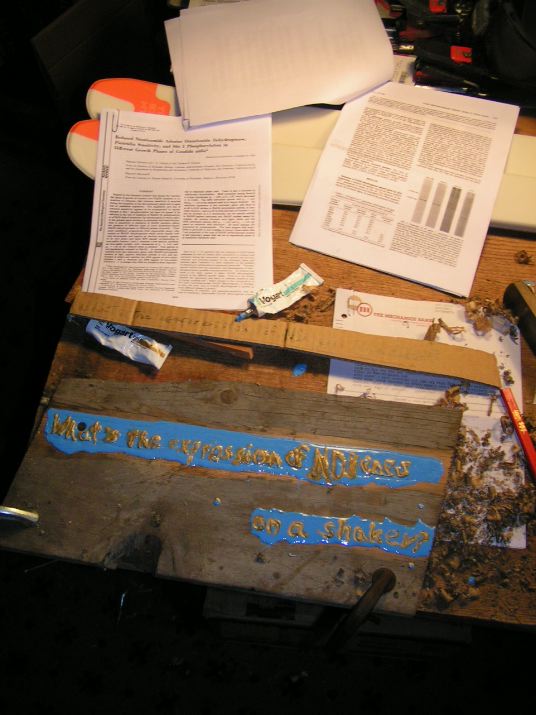
"Expression of ND" -- Richard Katz 2006

Knotty pine; Vogart Crafts Corporation fabric paint
The board spent many years as a shelf in a warehouse, so it has a nice patina of age. It got cut up to be part of a concrete form. It was used as a brace, though, not as part of the form proper, so it didn't end up with any concrete slag on it.
A path was cleared in two places with a low angle block plane.
The paint is from a company that lost a million dollars, on revenue of ten million, in 1987, Vogart Crafts Corporation of New York City.
The two painted lines of text say, "What's the expression of ND genes on a shaker?" The two painted lines are reminiscent of DNA strands, with a tail. Biological systems, like the DNA-as-information system, were built out of parts that were lying around, e.g. adenine. It's the A in ATP; it's the A in DNA; it's the A in NAD; it's the A in poly A. Who knows which one came first, and which ones were the spare parts?

The hanger is made from truncated bungee cords sacrificed for a different art project (the Richmond Armature prototypes.) It is a good example of something "made from parts lying around." It has no functional homology to the lengths of bungee cord rubber that constitute the spacers in a Richmond Armature. It has a structural homology to a native bungee cord; it's at least recognizable. It reminds one of a singlestranded polynucleotide, or a polysaccharide. Poly-anything; polypeptide even.
ND genes refers to NADH dehydrogenase genes ND1, ND2, ... , ND6 or so:
1. No homologs of these genes are to be found in the genome of Saccharomyces cerevisiae, leading to the idea that "yeast" don't have them. Saccharomyces cerevisiae is by far the genera franca of yeast for biological study.
2. "On a shaker" refers to microorganisms, but only for the cognoscenti.
3. "On a shaker" also means we must of necessity be looking at poor oxygenation, a fact unknown even to the cognoscenti;
4. The question being asked is what does this shaker culture do to the expression of ND genes?
Jasper Rine turns out to be exactly right -- if you're shaking S cerevisiae, it doesn't matter. But if you're shaking, say, Candida utilis, it probably matters a lot. I don't know exactly how, or how much. That's why they call them experiments.

Every detail supra is arcane. The esotericity can be summed up as resembling the canonical Zen koan about the single hand, "What's the sound of one hand clapping?" Generally speaking, you have to know a lot about something to start thinking about it; anybody who knows a lot about something is aware how little is known about anything, and how much is painfully unknown. So it is with these Zen things, and so it is with gene expression. What's the expression of genes that the organism doesn't have? None; no expression; none possible; but twenty years ago yeast scientists were doing experiments and writing papers about that very phenotype, NADH dehydrogenase NOT being expressed in S cerevisiae. That's all very well in retrospect; "... and that makes sense," we can hear the researcher say at the seminar he/she is giving on the subject of electron transport generally and yeast specifically. But this purposely rude, and at the same time luxuriant sculpture (that's real gold in that paint, and sometimes people pay real money for art, knowing that there's absolutely no way to know which pieces even by a given artist shall command a high price) is in the present, like any good piece of art; and inquires, "What about the expression of genes that depend on the environment, when nobody is aware that the microorganisms' environment is constantly changing drastically for the worse, like Schrodinger's cat?"
Richard Katz
November 2006